Taxation Law of Australia Assignment - LAWS20060, Term 2, 2019
VerifiedAdded on 2023/01/05
|20
|4118
|77
Homework Assignment
AI Summary
This document presents a detailed solution to a Taxation Law assignment, addressing key concepts within the Australian taxation system. The assignment covers a range of topics, including the application of TR Ruling 2019/1, Division 30 of the ITAA 1997, and marginal tax rates for individuals. It explores the taxation of capital gains, the tax-free threshold, and the implications of the Hayes v FCT case. Furthermore, it differentiates between ordinary and statutory income, and compares Medicare Levy and Medicare Levy Surcharge. The assignment also examines the concepts of "usual place of abode" and "permanent place of abode" in the context of Australian tax law. It analyzes the deductibility of various expenses, such as HECS-HELP repayments, travel costs, books, childcare, home repairs, and clothing, providing detailed explanations based on relevant legislation and case law. The solution includes references to various sections of the Income Tax Assessment Act 1997 (ITAA 1997) and relevant tax rulings and cases, providing a comprehensive overview of the subject matter.
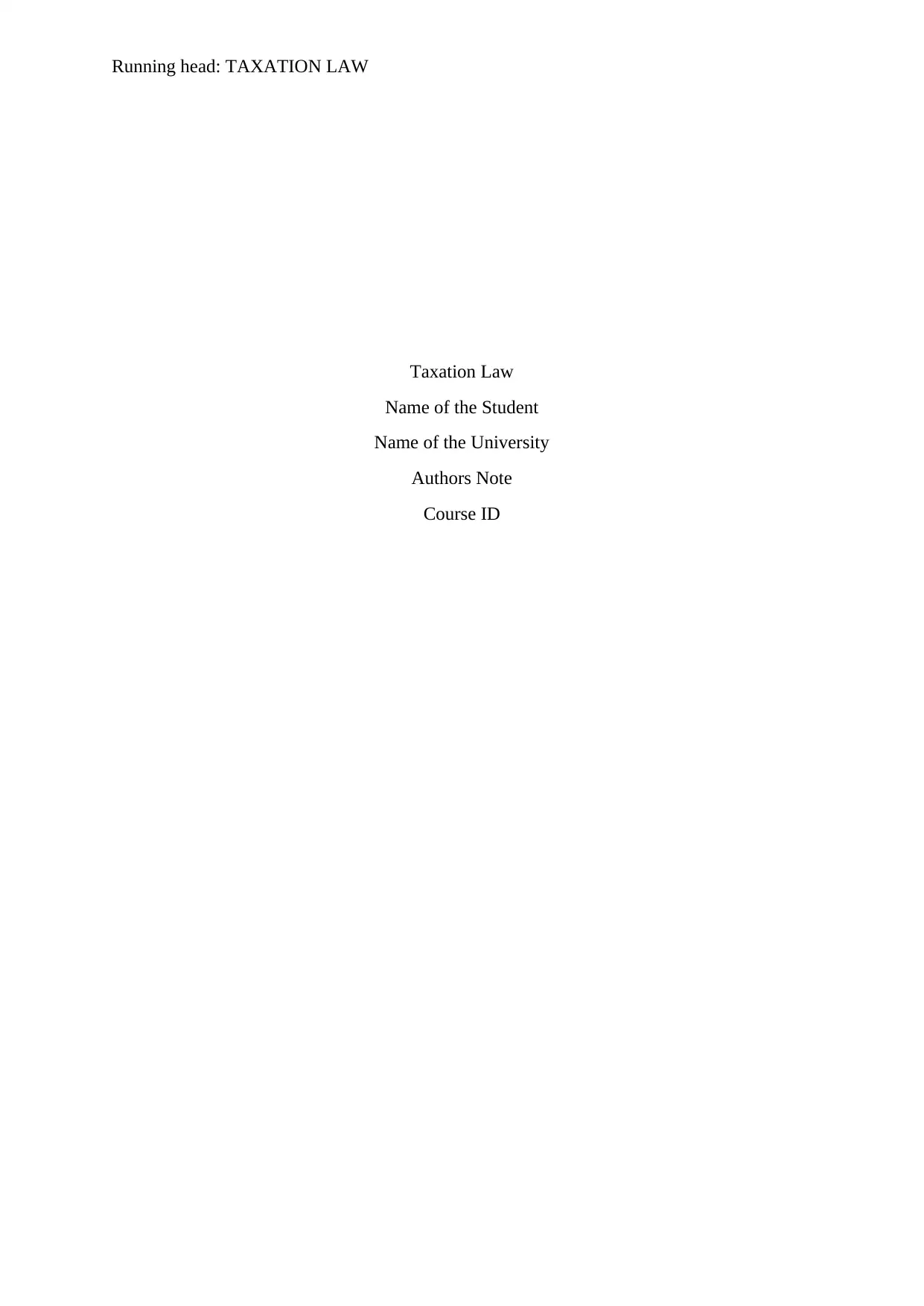
Running head: TAXATION LAW
Taxation Law
Name of the Student
Name of the University
Authors Note
Course ID
Taxation Law
Name of the Student
Name of the University
Authors Note
Course ID
Paraphrase This Document
Need a fresh take? Get an instant paraphrase of this document with our AI Paraphraser
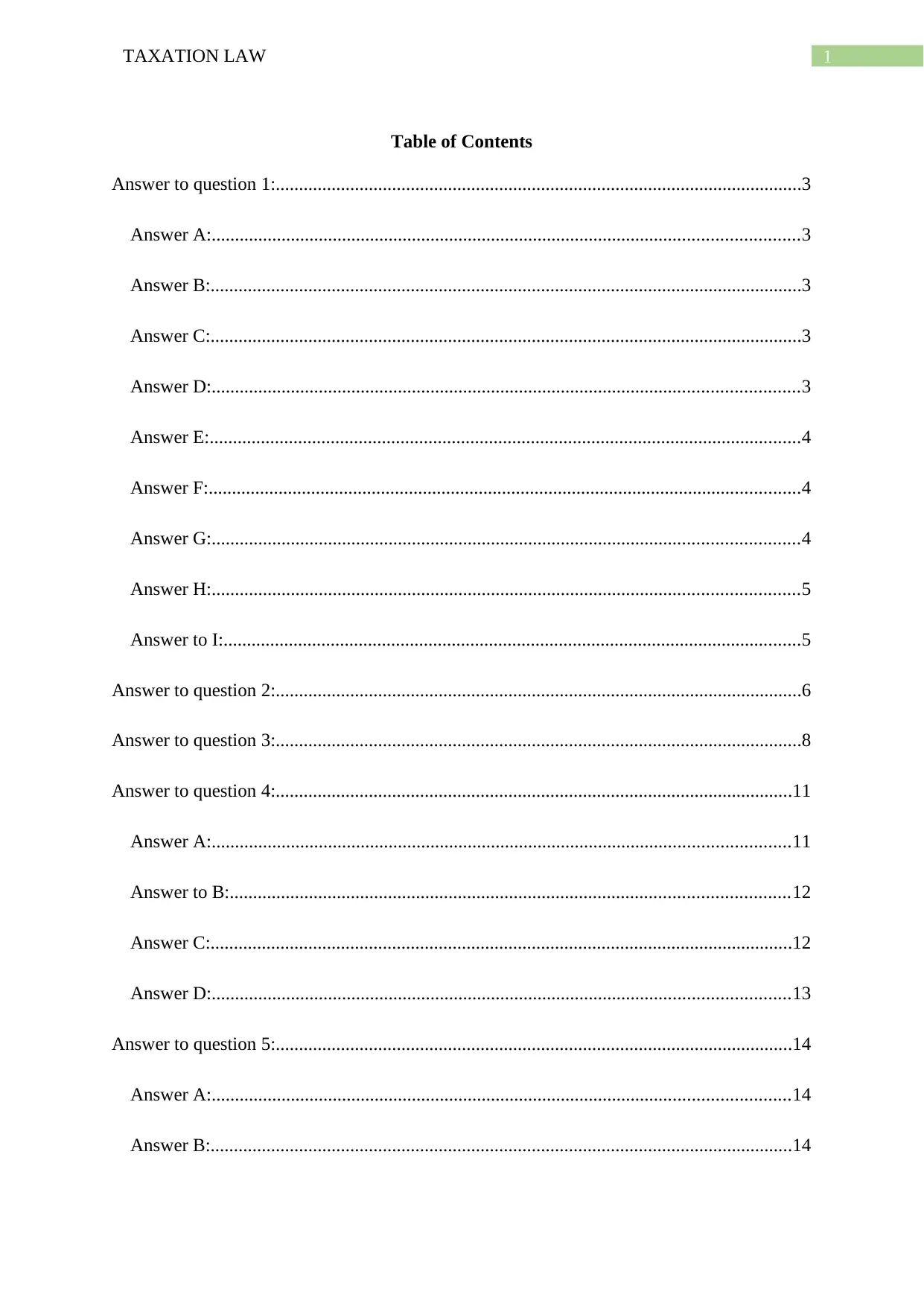
1TAXATION LAW
Table of Contents
Answer to question 1:.................................................................................................................3
Answer A:..............................................................................................................................3
Answer B:...............................................................................................................................3
Answer C:...............................................................................................................................3
Answer D:..............................................................................................................................3
Answer E:...............................................................................................................................4
Answer F:...............................................................................................................................4
Answer G:..............................................................................................................................4
Answer H:..............................................................................................................................5
Answer to I:............................................................................................................................5
Answer to question 2:.................................................................................................................6
Answer to question 3:.................................................................................................................8
Answer to question 4:...............................................................................................................11
Answer A:............................................................................................................................11
Answer to B:........................................................................................................................12
Answer C:.............................................................................................................................12
Answer D:............................................................................................................................13
Answer to question 5:...............................................................................................................14
Answer A:............................................................................................................................14
Answer B:.............................................................................................................................14
Table of Contents
Answer to question 1:.................................................................................................................3
Answer A:..............................................................................................................................3
Answer B:...............................................................................................................................3
Answer C:...............................................................................................................................3
Answer D:..............................................................................................................................3
Answer E:...............................................................................................................................4
Answer F:...............................................................................................................................4
Answer G:..............................................................................................................................4
Answer H:..............................................................................................................................5
Answer to I:............................................................................................................................5
Answer to question 2:.................................................................................................................6
Answer to question 3:.................................................................................................................8
Answer to question 4:...............................................................................................................11
Answer A:............................................................................................................................11
Answer to B:........................................................................................................................12
Answer C:.............................................................................................................................12
Answer D:............................................................................................................................13
Answer to question 5:...............................................................................................................14
Answer A:............................................................................................................................14
Answer B:.............................................................................................................................14
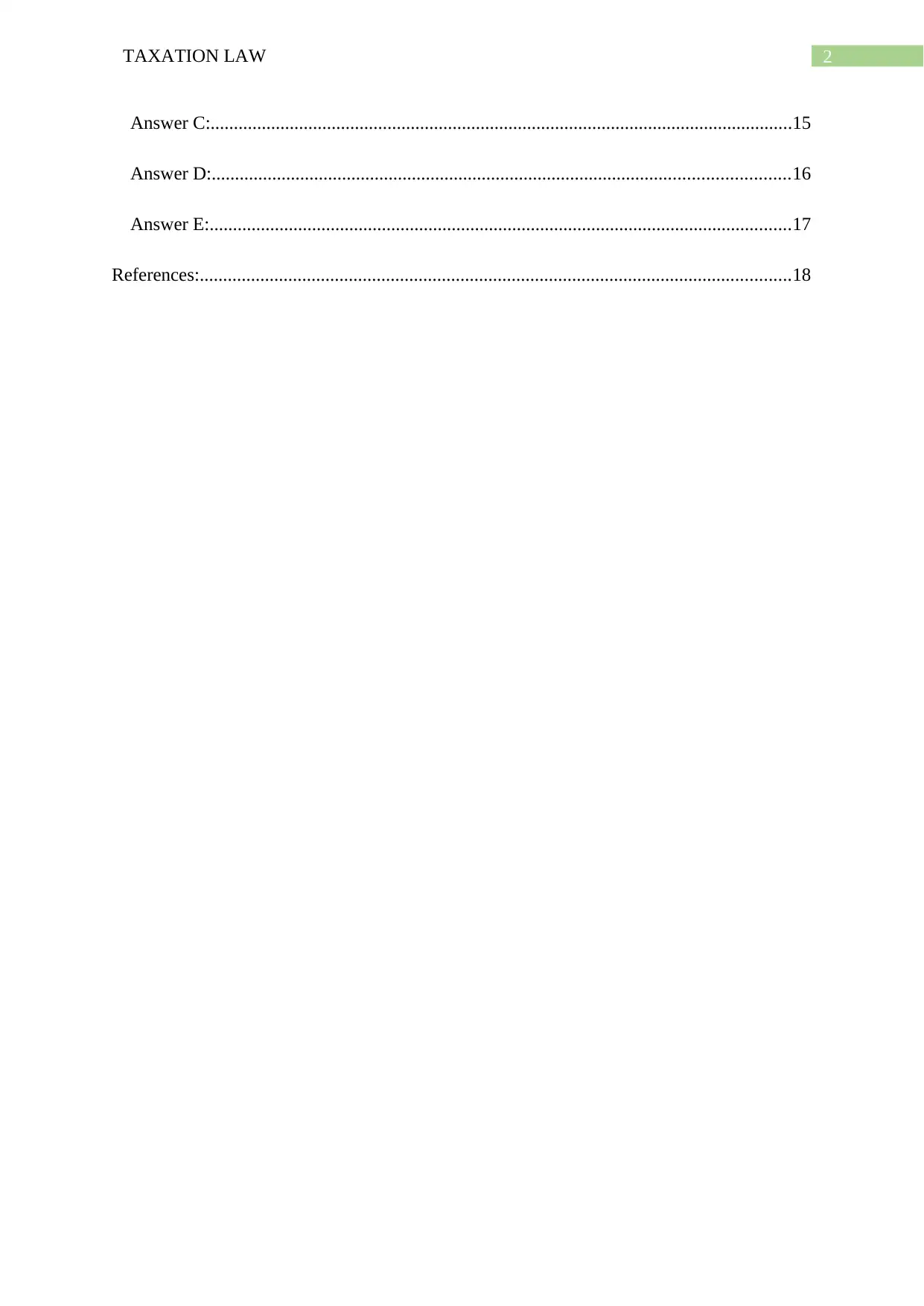
2TAXATION LAW
Answer C:.............................................................................................................................15
Answer D:............................................................................................................................16
Answer E:.............................................................................................................................17
References:...............................................................................................................................18
Answer C:.............................................................................................................................15
Answer D:............................................................................................................................16
Answer E:.............................................................................................................................17
References:...............................................................................................................................18
⊘ This is a preview!⊘
Do you want full access?
Subscribe today to unlock all pages.

Trusted by 1+ million students worldwide
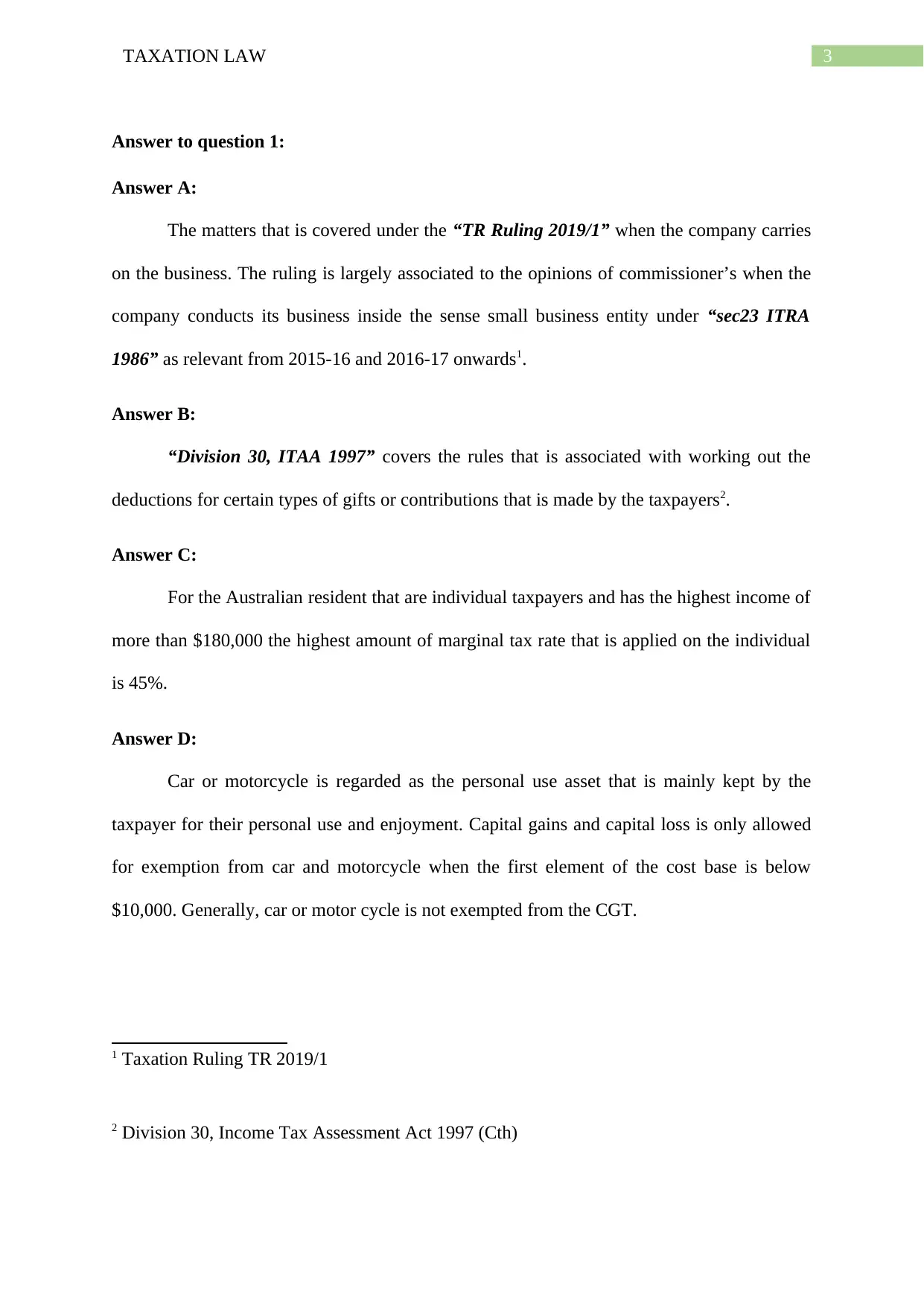
3TAXATION LAW
Answer to question 1:
Answer A:
The matters that is covered under the “TR Ruling 2019/1” when the company carries
on the business. The ruling is largely associated to the opinions of commissioner’s when the
company conducts its business inside the sense small business entity under “sec23 ITRA
1986” as relevant from 2015-16 and 2016-17 onwards1.
Answer B:
“Division 30, ITAA 1997” covers the rules that is associated with working out the
deductions for certain types of gifts or contributions that is made by the taxpayers2.
Answer C:
For the Australian resident that are individual taxpayers and has the highest income of
more than $180,000 the highest amount of marginal tax rate that is applied on the individual
is 45%.
Answer D:
Car or motorcycle is regarded as the personal use asset that is mainly kept by the
taxpayer for their personal use and enjoyment. Capital gains and capital loss is only allowed
for exemption from car and motorcycle when the first element of the cost base is below
$10,000. Generally, car or motor cycle is not exempted from the CGT.
1 Taxation Ruling TR 2019/1
2 Division 30, Income Tax Assessment Act 1997 (Cth)
Answer to question 1:
Answer A:
The matters that is covered under the “TR Ruling 2019/1” when the company carries
on the business. The ruling is largely associated to the opinions of commissioner’s when the
company conducts its business inside the sense small business entity under “sec23 ITRA
1986” as relevant from 2015-16 and 2016-17 onwards1.
Answer B:
“Division 30, ITAA 1997” covers the rules that is associated with working out the
deductions for certain types of gifts or contributions that is made by the taxpayers2.
Answer C:
For the Australian resident that are individual taxpayers and has the highest income of
more than $180,000 the highest amount of marginal tax rate that is applied on the individual
is 45%.
Answer D:
Car or motorcycle is regarded as the personal use asset that is mainly kept by the
taxpayer for their personal use and enjoyment. Capital gains and capital loss is only allowed
for exemption from car and motorcycle when the first element of the cost base is below
$10,000. Generally, car or motor cycle is not exempted from the CGT.
1 Taxation Ruling TR 2019/1
2 Division 30, Income Tax Assessment Act 1997 (Cth)
Paraphrase This Document
Need a fresh take? Get an instant paraphrase of this document with our AI Paraphraser
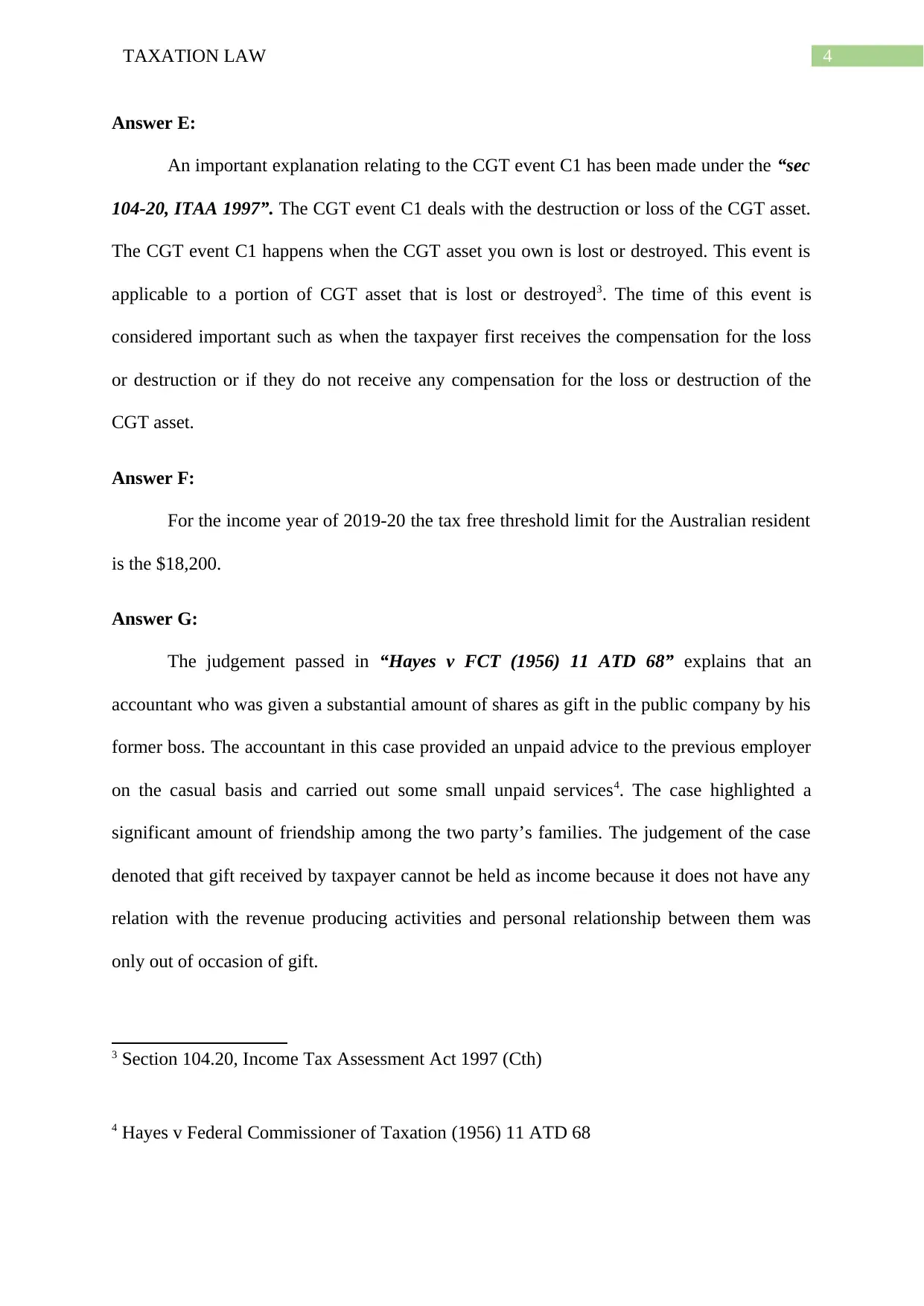
4TAXATION LAW
Answer E:
An important explanation relating to the CGT event C1 has been made under the “sec
104-20, ITAA 1997”. The CGT event C1 deals with the destruction or loss of the CGT asset.
The CGT event C1 happens when the CGT asset you own is lost or destroyed. This event is
applicable to a portion of CGT asset that is lost or destroyed3. The time of this event is
considered important such as when the taxpayer first receives the compensation for the loss
or destruction or if they do not receive any compensation for the loss or destruction of the
CGT asset.
Answer F:
For the income year of 2019-20 the tax free threshold limit for the Australian resident
is the $18,200.
Answer G:
The judgement passed in “Hayes v FCT (1956) 11 ATD 68” explains that an
accountant who was given a substantial amount of shares as gift in the public company by his
former boss. The accountant in this case provided an unpaid advice to the previous employer
on the casual basis and carried out some small unpaid services4. The case highlighted a
significant amount of friendship among the two party’s families. The judgement of the case
denoted that gift received by taxpayer cannot be held as income because it does not have any
relation with the revenue producing activities and personal relationship between them was
only out of occasion of gift.
3 Section 104.20, Income Tax Assessment Act 1997 (Cth)
4 Hayes v Federal Commissioner of Taxation (1956) 11 ATD 68
Answer E:
An important explanation relating to the CGT event C1 has been made under the “sec
104-20, ITAA 1997”. The CGT event C1 deals with the destruction or loss of the CGT asset.
The CGT event C1 happens when the CGT asset you own is lost or destroyed. This event is
applicable to a portion of CGT asset that is lost or destroyed3. The time of this event is
considered important such as when the taxpayer first receives the compensation for the loss
or destruction or if they do not receive any compensation for the loss or destruction of the
CGT asset.
Answer F:
For the income year of 2019-20 the tax free threshold limit for the Australian resident
is the $18,200.
Answer G:
The judgement passed in “Hayes v FCT (1956) 11 ATD 68” explains that an
accountant who was given a substantial amount of shares as gift in the public company by his
former boss. The accountant in this case provided an unpaid advice to the previous employer
on the casual basis and carried out some small unpaid services4. The case highlighted a
significant amount of friendship among the two party’s families. The judgement of the case
denoted that gift received by taxpayer cannot be held as income because it does not have any
relation with the revenue producing activities and personal relationship between them was
only out of occasion of gift.
3 Section 104.20, Income Tax Assessment Act 1997 (Cth)
4 Hayes v Federal Commissioner of Taxation (1956) 11 ATD 68
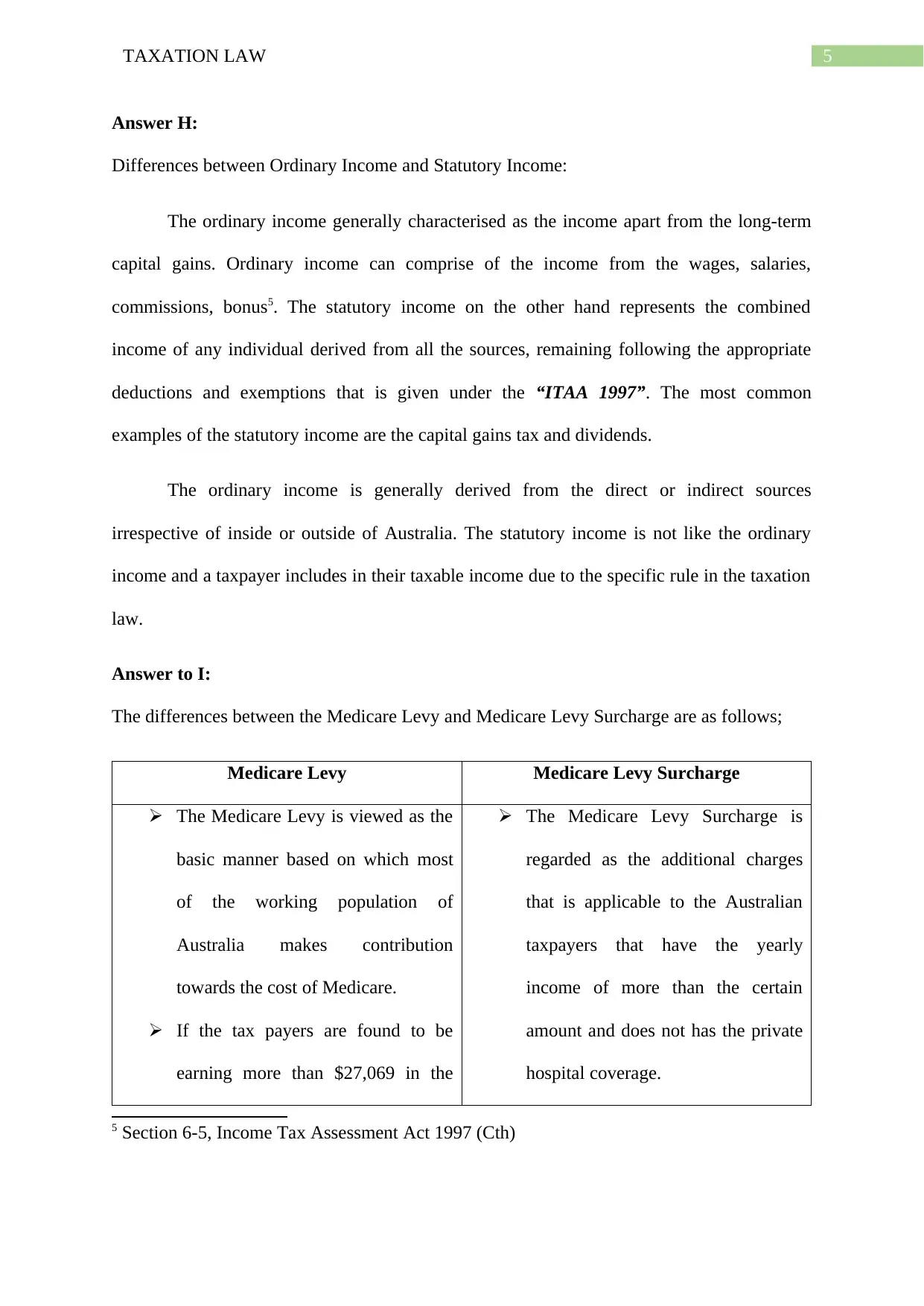
5TAXATION LAW
Answer H:
Differences between Ordinary Income and Statutory Income:
The ordinary income generally characterised as the income apart from the long-term
capital gains. Ordinary income can comprise of the income from the wages, salaries,
commissions, bonus5. The statutory income on the other hand represents the combined
income of any individual derived from all the sources, remaining following the appropriate
deductions and exemptions that is given under the “ITAA 1997”. The most common
examples of the statutory income are the capital gains tax and dividends.
The ordinary income is generally derived from the direct or indirect sources
irrespective of inside or outside of Australia. The statutory income is not like the ordinary
income and a taxpayer includes in their taxable income due to the specific rule in the taxation
law.
Answer to I:
The differences between the Medicare Levy and Medicare Levy Surcharge are as follows;
Medicare Levy Medicare Levy Surcharge
The Medicare Levy is viewed as the
basic manner based on which most
of the working population of
Australia makes contribution
towards the cost of Medicare.
If the tax payers are found to be
earning more than $27,069 in the
The Medicare Levy Surcharge is
regarded as the additional charges
that is applicable to the Australian
taxpayers that have the yearly
income of more than the certain
amount and does not has the private
hospital coverage.
5 Section 6-5, Income Tax Assessment Act 1997 (Cth)
Answer H:
Differences between Ordinary Income and Statutory Income:
The ordinary income generally characterised as the income apart from the long-term
capital gains. Ordinary income can comprise of the income from the wages, salaries,
commissions, bonus5. The statutory income on the other hand represents the combined
income of any individual derived from all the sources, remaining following the appropriate
deductions and exemptions that is given under the “ITAA 1997”. The most common
examples of the statutory income are the capital gains tax and dividends.
The ordinary income is generally derived from the direct or indirect sources
irrespective of inside or outside of Australia. The statutory income is not like the ordinary
income and a taxpayer includes in their taxable income due to the specific rule in the taxation
law.
Answer to I:
The differences between the Medicare Levy and Medicare Levy Surcharge are as follows;
Medicare Levy Medicare Levy Surcharge
The Medicare Levy is viewed as the
basic manner based on which most
of the working population of
Australia makes contribution
towards the cost of Medicare.
If the tax payers are found to be
earning more than $27,069 in the
The Medicare Levy Surcharge is
regarded as the additional charges
that is applicable to the Australian
taxpayers that have the yearly
income of more than the certain
amount and does not has the private
hospital coverage.
5 Section 6-5, Income Tax Assessment Act 1997 (Cth)
⊘ This is a preview!⊘
Do you want full access?
Subscribe today to unlock all pages.

Trusted by 1+ million students worldwide
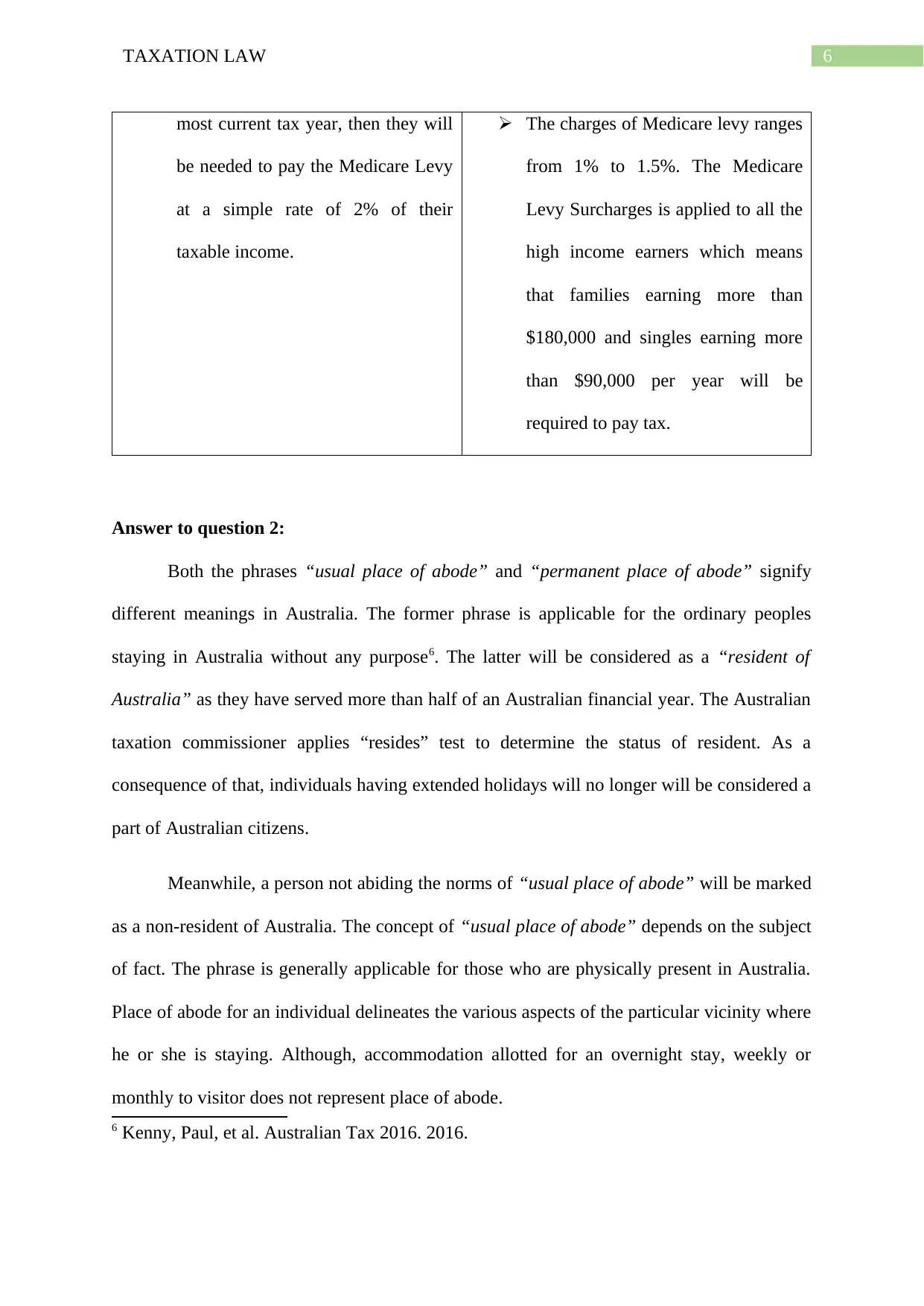
6TAXATION LAW
most current tax year, then they will
be needed to pay the Medicare Levy
at a simple rate of 2% of their
taxable income.
The charges of Medicare levy ranges
from 1% to 1.5%. The Medicare
Levy Surcharges is applied to all the
high income earners which means
that families earning more than
$180,000 and singles earning more
than $90,000 per year will be
required to pay tax.
Answer to question 2:
Both the phrases “usual place of abode” and “permanent place of abode” signify
different meanings in Australia. The former phrase is applicable for the ordinary peoples
staying in Australia without any purpose6. The latter will be considered as a “resident of
Australia” as they have served more than half of an Australian financial year. The Australian
taxation commissioner applies “resides” test to determine the status of resident. As a
consequence of that, individuals having extended holidays will no longer will be considered a
part of Australian citizens.
Meanwhile, a person not abiding the norms of “usual place of abode” will be marked
as a non-resident of Australia. The concept of “usual place of abode” depends on the subject
of fact. The phrase is generally applicable for those who are physically present in Australia.
Place of abode for an individual delineates the various aspects of the particular vicinity where
he or she is staying. Although, accommodation allotted for an overnight stay, weekly or
monthly to visitor does not represent place of abode.
6 Kenny, Paul, et al. Australian Tax 2016. 2016.
most current tax year, then they will
be needed to pay the Medicare Levy
at a simple rate of 2% of their
taxable income.
The charges of Medicare levy ranges
from 1% to 1.5%. The Medicare
Levy Surcharges is applied to all the
high income earners which means
that families earning more than
$180,000 and singles earning more
than $90,000 per year will be
required to pay tax.
Answer to question 2:
Both the phrases “usual place of abode” and “permanent place of abode” signify
different meanings in Australia. The former phrase is applicable for the ordinary peoples
staying in Australia without any purpose6. The latter will be considered as a “resident of
Australia” as they have served more than half of an Australian financial year. The Australian
taxation commissioner applies “resides” test to determine the status of resident. As a
consequence of that, individuals having extended holidays will no longer will be considered a
part of Australian citizens.
Meanwhile, a person not abiding the norms of “usual place of abode” will be marked
as a non-resident of Australia. The concept of “usual place of abode” depends on the subject
of fact. The phrase is generally applicable for those who are physically present in Australia.
Place of abode for an individual delineates the various aspects of the particular vicinity where
he or she is staying. Although, accommodation allotted for an overnight stay, weekly or
monthly to visitor does not represent place of abode.
6 Kenny, Paul, et al. Australian Tax 2016. 2016.
Paraphrase This Document
Need a fresh take? Get an instant paraphrase of this document with our AI Paraphraser
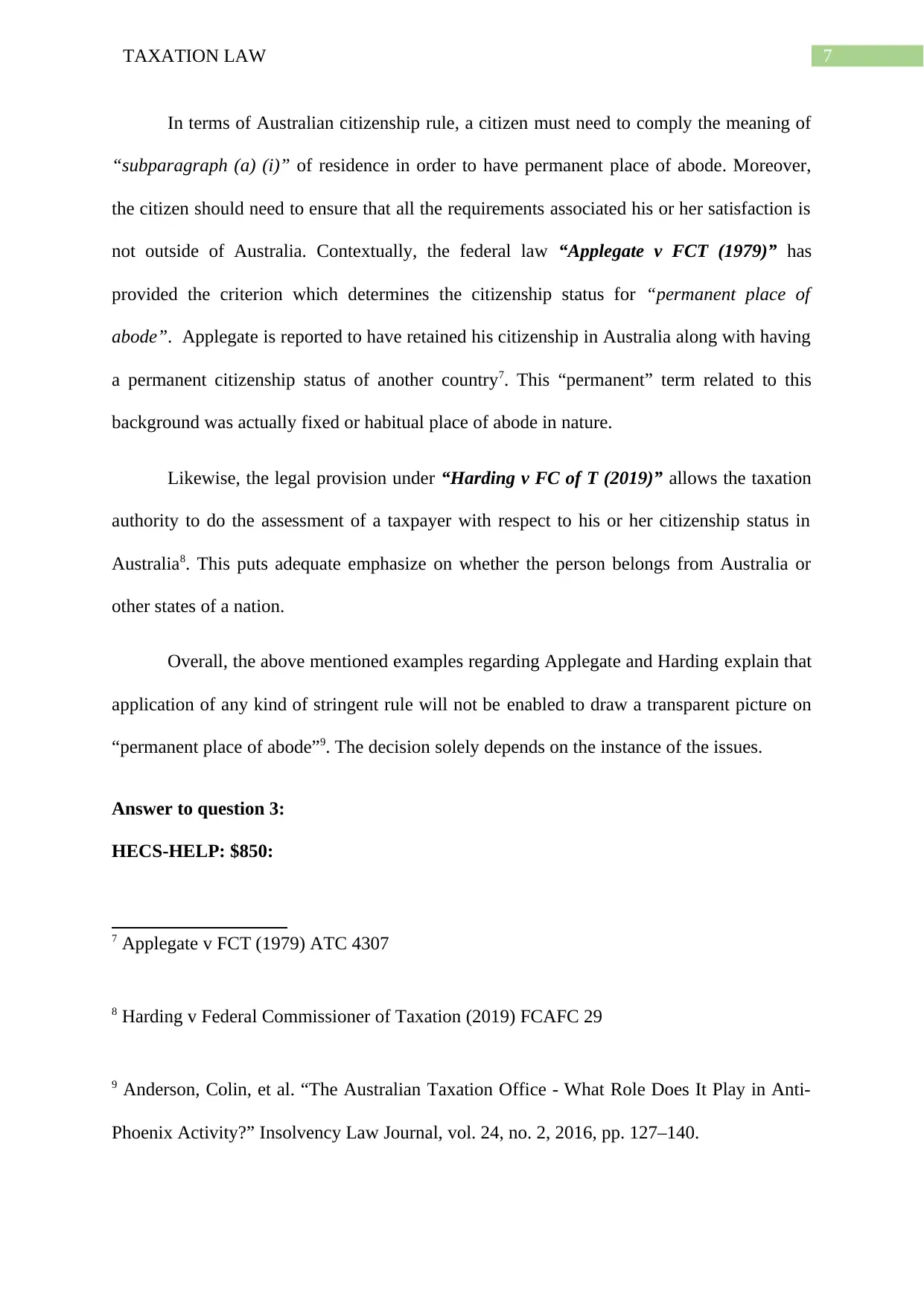
7TAXATION LAW
In terms of Australian citizenship rule, a citizen must need to comply the meaning of
“subparagraph (a) (i)” of residence in order to have permanent place of abode. Moreover,
the citizen should need to ensure that all the requirements associated his or her satisfaction is
not outside of Australia. Contextually, the federal law “Applegate v FCT (1979)” has
provided the criterion which determines the citizenship status for “permanent place of
abode”. Applegate is reported to have retained his citizenship in Australia along with having
a permanent citizenship status of another country7. This “permanent” term related to this
background was actually fixed or habitual place of abode in nature.
Likewise, the legal provision under “Harding v FC of T (2019)” allows the taxation
authority to do the assessment of a taxpayer with respect to his or her citizenship status in
Australia8. This puts adequate emphasize on whether the person belongs from Australia or
other states of a nation.
Overall, the above mentioned examples regarding Applegate and Harding explain that
application of any kind of stringent rule will not be enabled to draw a transparent picture on
“permanent place of abode”9. The decision solely depends on the instance of the issues.
Answer to question 3:
HECS-HELP: $850:
7 Applegate v FCT (1979) ATC 4307
8 Harding v Federal Commissioner of Taxation (2019) FCAFC 29
9 Anderson, Colin, et al. “The Australian Taxation Office - What Role Does It Play in Anti-
Phoenix Activity?” Insolvency Law Journal, vol. 24, no. 2, 2016, pp. 127–140.
In terms of Australian citizenship rule, a citizen must need to comply the meaning of
“subparagraph (a) (i)” of residence in order to have permanent place of abode. Moreover,
the citizen should need to ensure that all the requirements associated his or her satisfaction is
not outside of Australia. Contextually, the federal law “Applegate v FCT (1979)” has
provided the criterion which determines the citizenship status for “permanent place of
abode”. Applegate is reported to have retained his citizenship in Australia along with having
a permanent citizenship status of another country7. This “permanent” term related to this
background was actually fixed or habitual place of abode in nature.
Likewise, the legal provision under “Harding v FC of T (2019)” allows the taxation
authority to do the assessment of a taxpayer with respect to his or her citizenship status in
Australia8. This puts adequate emphasize on whether the person belongs from Australia or
other states of a nation.
Overall, the above mentioned examples regarding Applegate and Harding explain that
application of any kind of stringent rule will not be enabled to draw a transparent picture on
“permanent place of abode”9. The decision solely depends on the instance of the issues.
Answer to question 3:
HECS-HELP: $850:
7 Applegate v FCT (1979) ATC 4307
8 Harding v Federal Commissioner of Taxation (2019) FCAFC 29
9 Anderson, Colin, et al. “The Australian Taxation Office - What Role Does It Play in Anti-
Phoenix Activity?” Insolvency Law Journal, vol. 24, no. 2, 2016, pp. 127–140.
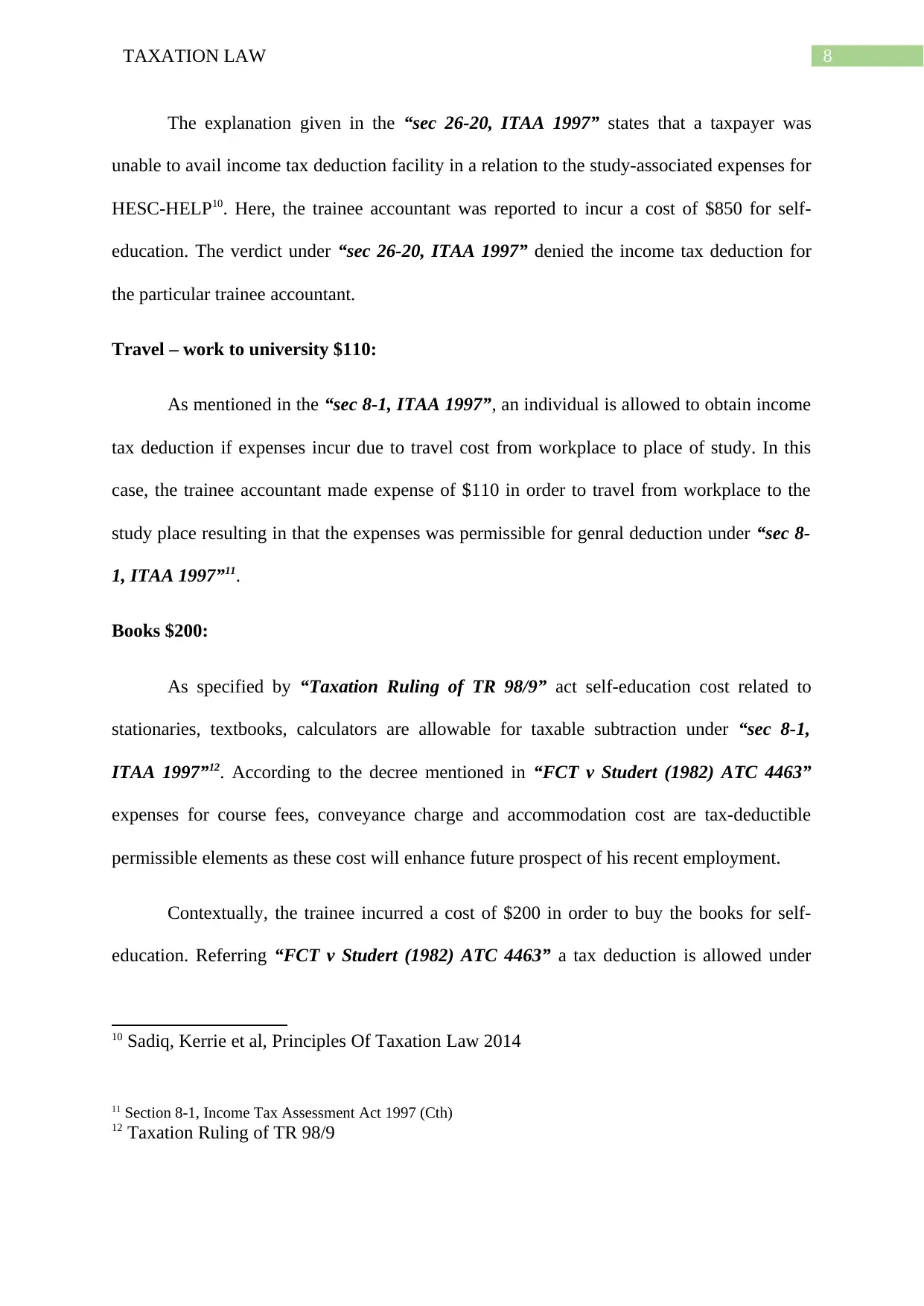
8TAXATION LAW
The explanation given in the “sec 26-20, ITAA 1997” states that a taxpayer was
unable to avail income tax deduction facility in a relation to the study-associated expenses for
HESC-HELP10. Here, the trainee accountant was reported to incur a cost of $850 for self-
education. The verdict under “sec 26-20, ITAA 1997” denied the income tax deduction for
the particular trainee accountant.
Travel – work to university $110:
As mentioned in the “sec 8-1, ITAA 1997”, an individual is allowed to obtain income
tax deduction if expenses incur due to travel cost from workplace to place of study. In this
case, the trainee accountant made expense of $110 in order to travel from workplace to the
study place resulting in that the expenses was permissible for genral deduction under “sec 8-
1, ITAA 1997”11.
Books $200:
As specified by “Taxation Ruling of TR 98/9” act self-education cost related to
stationaries, textbooks, calculators are allowable for taxable subtraction under “sec 8-1,
ITAA 1997”12. According to the decree mentioned in “FCT v Studert (1982) ATC 4463”
expenses for course fees, conveyance charge and accommodation cost are tax-deductible
permissible elements as these cost will enhance future prospect of his recent employment.
Contextually, the trainee incurred a cost of $200 in order to buy the books for self-
education. Referring “FCT v Studert (1982) ATC 4463” a tax deduction is allowed under
10 Sadiq, Kerrie et al, Principles Of Taxation Law 2014
11 Section 8-1, Income Tax Assessment Act 1997 (Cth)
12 Taxation Ruling of TR 98/9
The explanation given in the “sec 26-20, ITAA 1997” states that a taxpayer was
unable to avail income tax deduction facility in a relation to the study-associated expenses for
HESC-HELP10. Here, the trainee accountant was reported to incur a cost of $850 for self-
education. The verdict under “sec 26-20, ITAA 1997” denied the income tax deduction for
the particular trainee accountant.
Travel – work to university $110:
As mentioned in the “sec 8-1, ITAA 1997”, an individual is allowed to obtain income
tax deduction if expenses incur due to travel cost from workplace to place of study. In this
case, the trainee accountant made expense of $110 in order to travel from workplace to the
study place resulting in that the expenses was permissible for genral deduction under “sec 8-
1, ITAA 1997”11.
Books $200:
As specified by “Taxation Ruling of TR 98/9” act self-education cost related to
stationaries, textbooks, calculators are allowable for taxable subtraction under “sec 8-1,
ITAA 1997”12. According to the decree mentioned in “FCT v Studert (1982) ATC 4463”
expenses for course fees, conveyance charge and accommodation cost are tax-deductible
permissible elements as these cost will enhance future prospect of his recent employment.
Contextually, the trainee incurred a cost of $200 in order to buy the books for self-
education. Referring “FCT v Studert (1982) ATC 4463” a tax deduction is allowed under
10 Sadiq, Kerrie et al, Principles Of Taxation Law 2014
11 Section 8-1, Income Tax Assessment Act 1997 (Cth)
12 Taxation Ruling of TR 98/9
⊘ This is a preview!⊘
Do you want full access?
Subscribe today to unlock all pages.

Trusted by 1+ million students worldwide
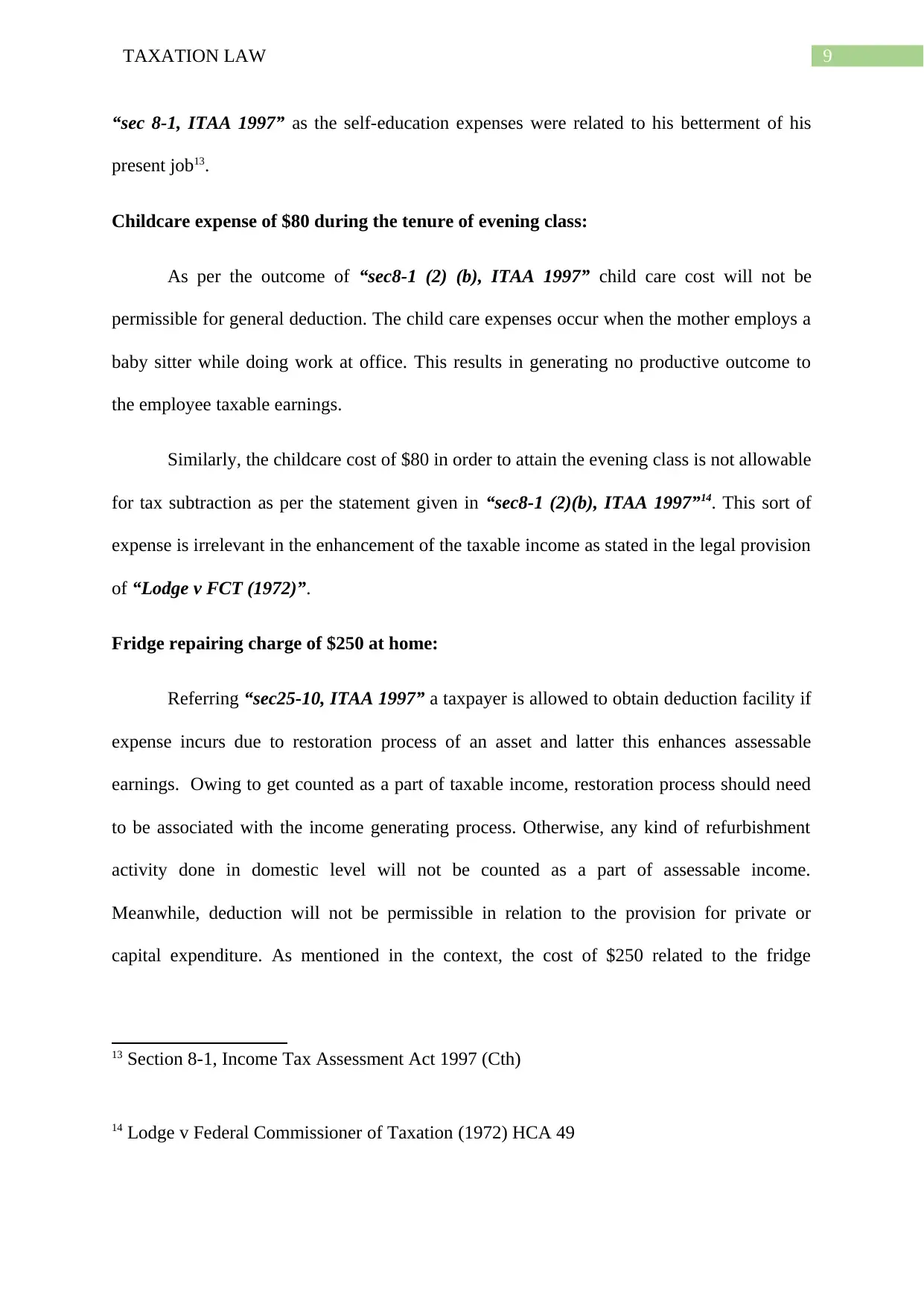
9TAXATION LAW
“sec 8-1, ITAA 1997” as the self-education expenses were related to his betterment of his
present job13.
Childcare expense of $80 during the tenure of evening class:
As per the outcome of “sec8-1 (2) (b), ITAA 1997” child care cost will not be
permissible for general deduction. The child care expenses occur when the mother employs a
baby sitter while doing work at office. This results in generating no productive outcome to
the employee taxable earnings.
Similarly, the childcare cost of $80 in order to attain the evening class is not allowable
for tax subtraction as per the statement given in “sec8-1 (2)(b), ITAA 1997”14. This sort of
expense is irrelevant in the enhancement of the taxable income as stated in the legal provision
of “Lodge v FCT (1972)”.
Fridge repairing charge of $250 at home:
Referring “sec25-10, ITAA 1997” a taxpayer is allowed to obtain deduction facility if
expense incurs due to restoration process of an asset and latter this enhances assessable
earnings. Owing to get counted as a part of taxable income, restoration process should need
to be associated with the income generating process. Otherwise, any kind of refurbishment
activity done in domestic level will not be counted as a part of assessable income.
Meanwhile, deduction will not be permissible in relation to the provision for private or
capital expenditure. As mentioned in the context, the cost of $250 related to the fridge
13 Section 8-1, Income Tax Assessment Act 1997 (Cth)
14 Lodge v Federal Commissioner of Taxation (1972) HCA 49
“sec 8-1, ITAA 1997” as the self-education expenses were related to his betterment of his
present job13.
Childcare expense of $80 during the tenure of evening class:
As per the outcome of “sec8-1 (2) (b), ITAA 1997” child care cost will not be
permissible for general deduction. The child care expenses occur when the mother employs a
baby sitter while doing work at office. This results in generating no productive outcome to
the employee taxable earnings.
Similarly, the childcare cost of $80 in order to attain the evening class is not allowable
for tax subtraction as per the statement given in “sec8-1 (2)(b), ITAA 1997”14. This sort of
expense is irrelevant in the enhancement of the taxable income as stated in the legal provision
of “Lodge v FCT (1972)”.
Fridge repairing charge of $250 at home:
Referring “sec25-10, ITAA 1997” a taxpayer is allowed to obtain deduction facility if
expense incurs due to restoration process of an asset and latter this enhances assessable
earnings. Owing to get counted as a part of taxable income, restoration process should need
to be associated with the income generating process. Otherwise, any kind of refurbishment
activity done in domestic level will not be counted as a part of assessable income.
Meanwhile, deduction will not be permissible in relation to the provision for private or
capital expenditure. As mentioned in the context, the cost of $250 related to the fridge
13 Section 8-1, Income Tax Assessment Act 1997 (Cth)
14 Lodge v Federal Commissioner of Taxation (1972) HCA 49
Paraphrase This Document
Need a fresh take? Get an instant paraphrase of this document with our AI Paraphraser
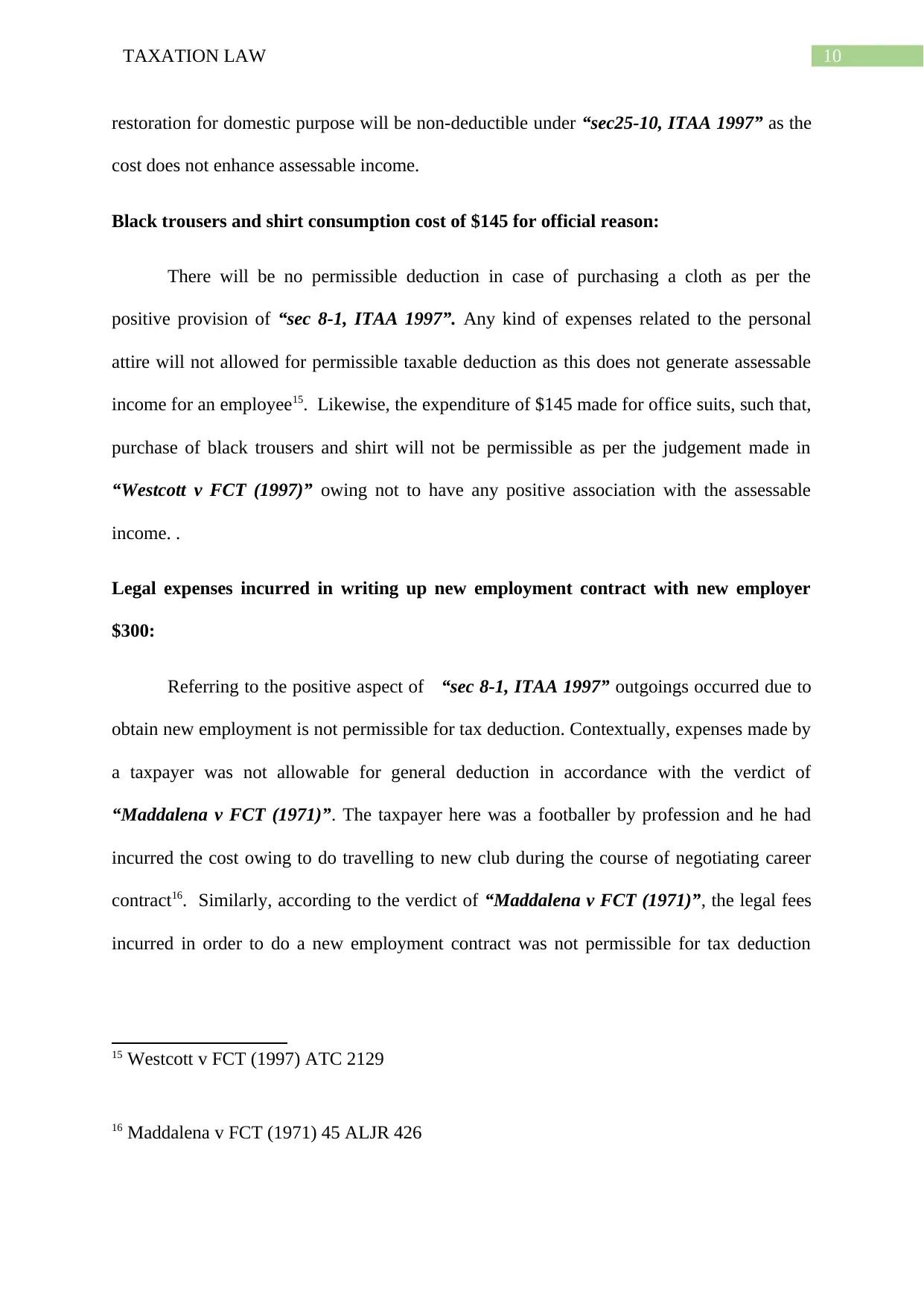
10TAXATION LAW
restoration for domestic purpose will be non-deductible under “sec25-10, ITAA 1997” as the
cost does not enhance assessable income.
Black trousers and shirt consumption cost of $145 for official reason:
There will be no permissible deduction in case of purchasing a cloth as per the
positive provision of “sec 8-1, ITAA 1997”. Any kind of expenses related to the personal
attire will not allowed for permissible taxable deduction as this does not generate assessable
income for an employee15. Likewise, the expenditure of $145 made for office suits, such that,
purchase of black trousers and shirt will not be permissible as per the judgement made in
“Westcott v FCT (1997)” owing not to have any positive association with the assessable
income. .
Legal expenses incurred in writing up new employment contract with new employer
$300:
Referring to the positive aspect of “sec 8-1, ITAA 1997” outgoings occurred due to
obtain new employment is not permissible for tax deduction. Contextually, expenses made by
a taxpayer was not allowable for general deduction in accordance with the verdict of
“Maddalena v FCT (1971)”. The taxpayer here was a footballer by profession and he had
incurred the cost owing to do travelling to new club during the course of negotiating career
contract16. Similarly, according to the verdict of “Maddalena v FCT (1971)”, the legal fees
incurred in order to do a new employment contract was not permissible for tax deduction
15 Westcott v FCT (1997) ATC 2129
16 Maddalena v FCT (1971) 45 ALJR 426
restoration for domestic purpose will be non-deductible under “sec25-10, ITAA 1997” as the
cost does not enhance assessable income.
Black trousers and shirt consumption cost of $145 for official reason:
There will be no permissible deduction in case of purchasing a cloth as per the
positive provision of “sec 8-1, ITAA 1997”. Any kind of expenses related to the personal
attire will not allowed for permissible taxable deduction as this does not generate assessable
income for an employee15. Likewise, the expenditure of $145 made for office suits, such that,
purchase of black trousers and shirt will not be permissible as per the judgement made in
“Westcott v FCT (1997)” owing not to have any positive association with the assessable
income. .
Legal expenses incurred in writing up new employment contract with new employer
$300:
Referring to the positive aspect of “sec 8-1, ITAA 1997” outgoings occurred due to
obtain new employment is not permissible for tax deduction. Contextually, expenses made by
a taxpayer was not allowable for general deduction in accordance with the verdict of
“Maddalena v FCT (1971)”. The taxpayer here was a footballer by profession and he had
incurred the cost owing to do travelling to new club during the course of negotiating career
contract16. Similarly, according to the verdict of “Maddalena v FCT (1971)”, the legal fees
incurred in order to do a new employment contract was not permissible for tax deduction
15 Westcott v FCT (1997) ATC 2129
16 Maddalena v FCT (1971) 45 ALJR 426
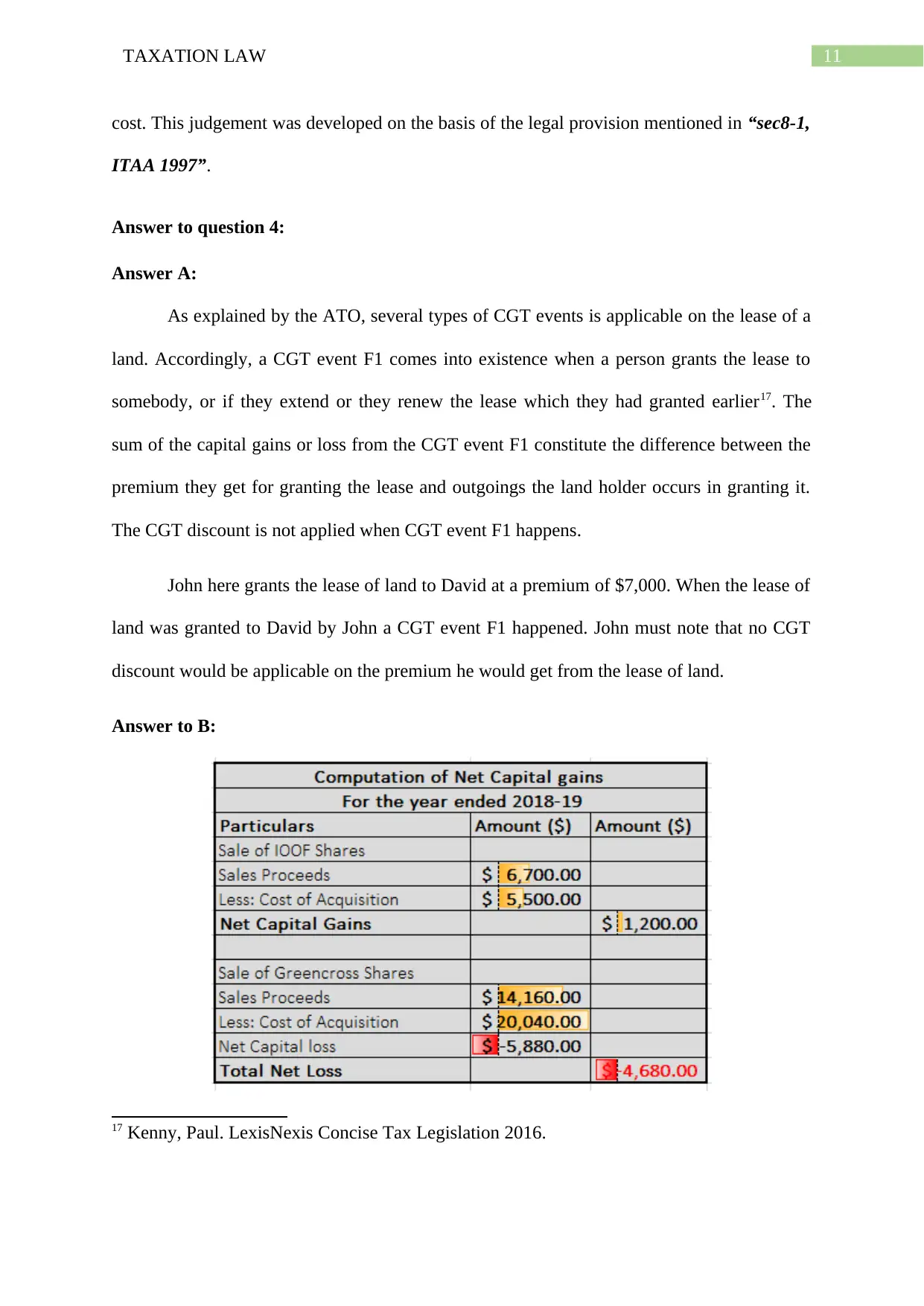
11TAXATION LAW
cost. This judgement was developed on the basis of the legal provision mentioned in “sec8-1,
ITAA 1997”.
Answer to question 4:
Answer A:
As explained by the ATO, several types of CGT events is applicable on the lease of a
land. Accordingly, a CGT event F1 comes into existence when a person grants the lease to
somebody, or if they extend or they renew the lease which they had granted earlier17. The
sum of the capital gains or loss from the CGT event F1 constitute the difference between the
premium they get for granting the lease and outgoings the land holder occurs in granting it.
The CGT discount is not applied when CGT event F1 happens.
John here grants the lease of land to David at a premium of $7,000. When the lease of
land was granted to David by John a CGT event F1 happened. John must note that no CGT
discount would be applicable on the premium he would get from the lease of land.
Answer to B:
17 Kenny, Paul. LexisNexis Concise Tax Legislation 2016.
cost. This judgement was developed on the basis of the legal provision mentioned in “sec8-1,
ITAA 1997”.
Answer to question 4:
Answer A:
As explained by the ATO, several types of CGT events is applicable on the lease of a
land. Accordingly, a CGT event F1 comes into existence when a person grants the lease to
somebody, or if they extend or they renew the lease which they had granted earlier17. The
sum of the capital gains or loss from the CGT event F1 constitute the difference between the
premium they get for granting the lease and outgoings the land holder occurs in granting it.
The CGT discount is not applied when CGT event F1 happens.
John here grants the lease of land to David at a premium of $7,000. When the lease of
land was granted to David by John a CGT event F1 happened. John must note that no CGT
discount would be applicable on the premium he would get from the lease of land.
Answer to B:
17 Kenny, Paul. LexisNexis Concise Tax Legislation 2016.
⊘ This is a preview!⊘
Do you want full access?
Subscribe today to unlock all pages.

Trusted by 1+ million students worldwide
1 out of 20
Related Documents
Your All-in-One AI-Powered Toolkit for Academic Success.
+13062052269
info@desklib.com
Available 24*7 on WhatsApp / Email
![[object Object]](/_next/static/media/star-bottom.7253800d.svg)
Unlock your academic potential
Copyright © 2020–2025 A2Z Services. All Rights Reserved. Developed and managed by ZUCOL.





